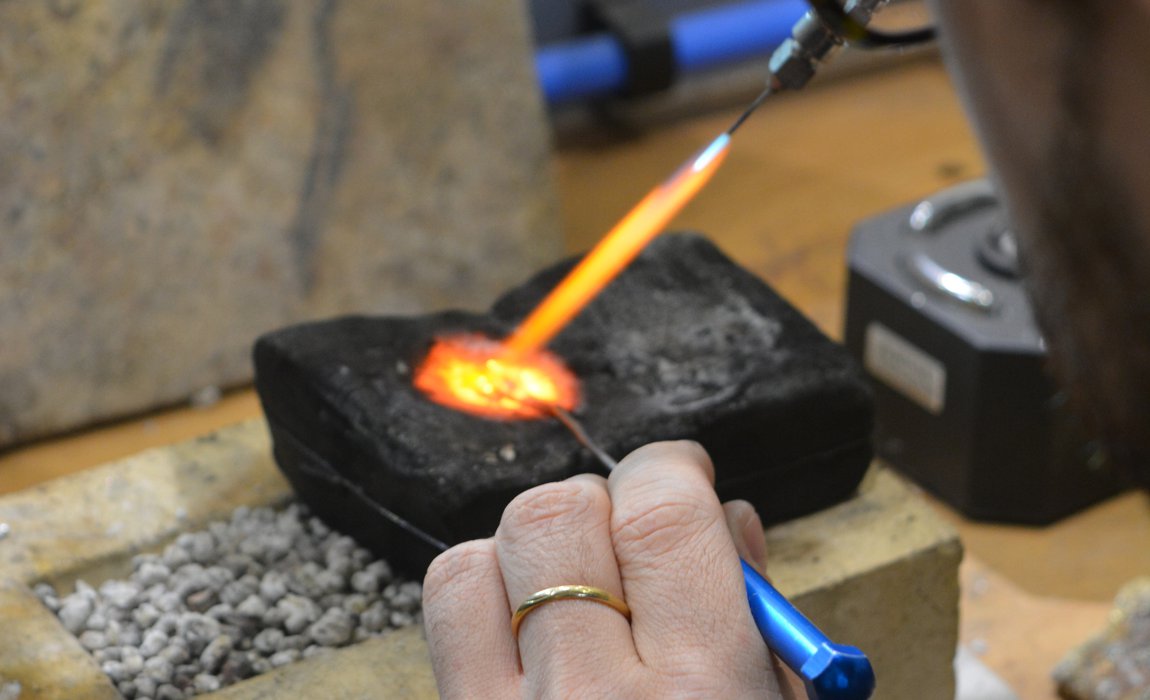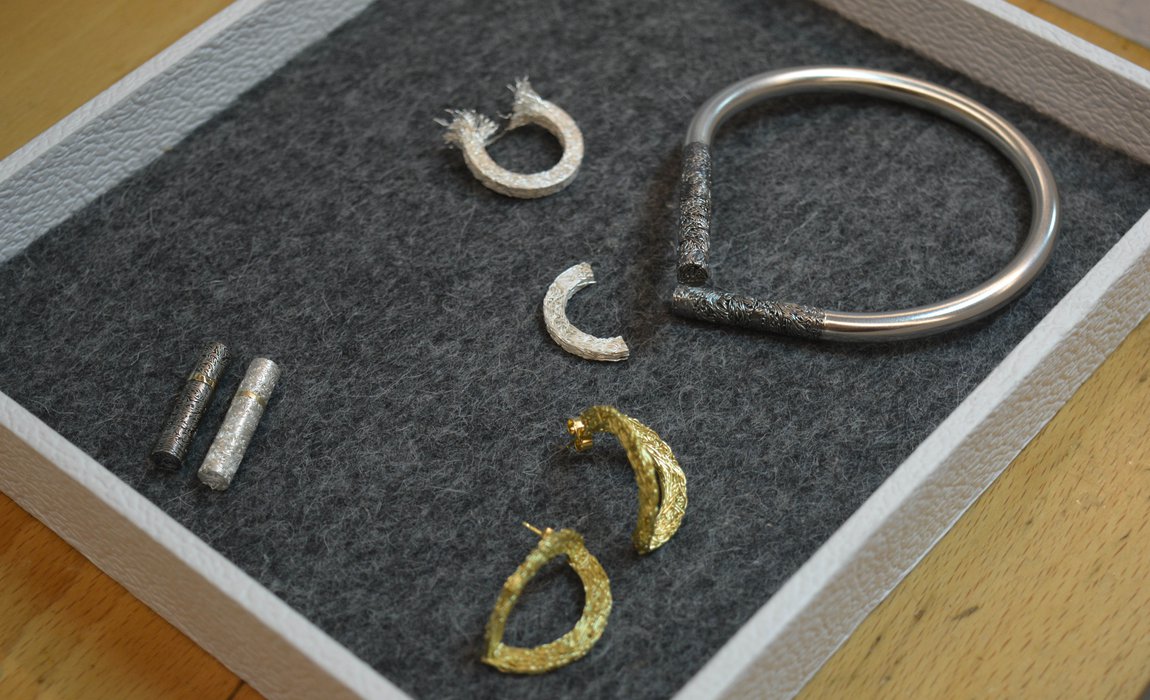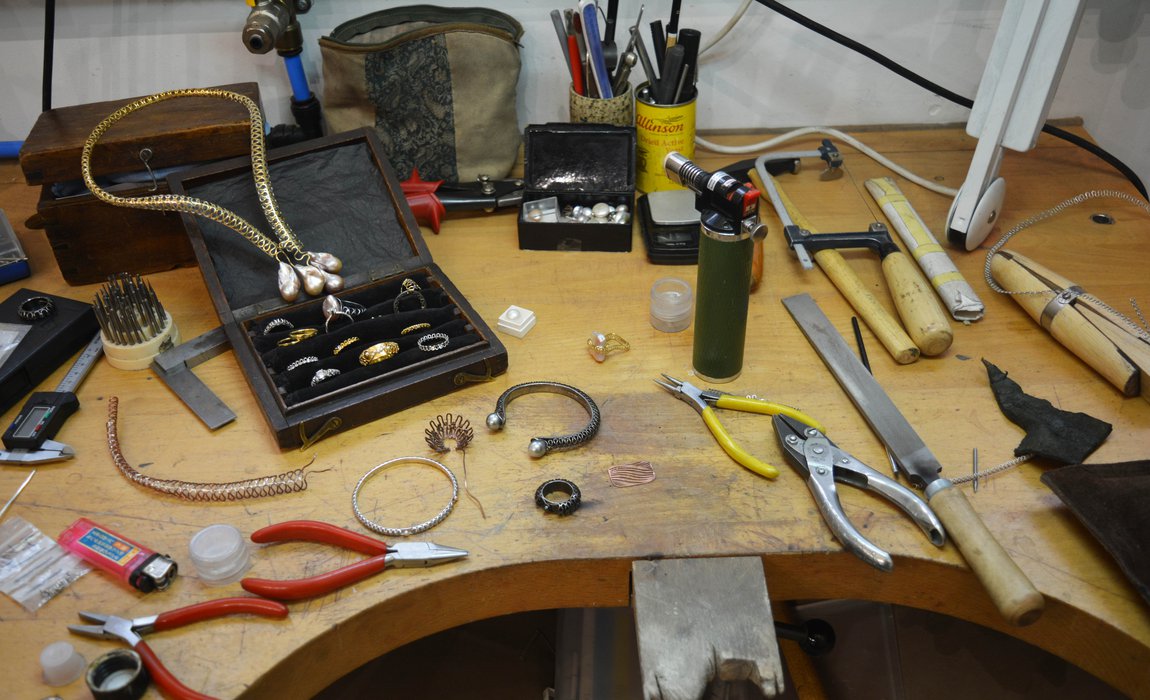Textile embroidery, jewellery, silversmithing: The story and current work of the Worshipful Company of Gold and Silver Wyre Drawers
The Worshipful Company of Gold and Silver Wyre Drawers, with its motto ‘amacitiam trahit amor’ (love draws forth friendship), has played a pivotal role in bringing together jewellers, silversmiths and textile embroiderers with a passion for working with hand drawn wire in innovative ways, since the 17th century.
Today the Livery Company still promotes public interest and understanding of the art of gold and silver wire drawing and its uses, both ancient and modern. In celebration of the future exhibition and events programme Drawn+Formed: Contemporary Work with Gold and Silver Wire at the Goldsmiths’ Centre, Charlotte Dew speaks to current Master Michael Gunston of the GSWD and Jean Scott-Moncrieff, a designer maker and Liveryman, about the its role today, the innovative uses of drawn wire and how the pandemic has had an impact on its members as well as the bright future for this unique craft.
Watch Charlotte Dew in conversation with Master Michael Guston and Liveryman Jean Scott-Moncrieff
Charlotte: Hello, my name is Charlotte Dew. I am the Public Programme Manager at the Goldsmiths’ Centre and I am thrilled to be joined this afternoon by Michael Guston who is the Master at the Worshipful Company of Gold and Silver Wyre Drawers and also Jean Scott-Moncrieff who is here to represent the makers of the Company and is herself a designer maker.
So, Michael can I start by asking you to introduce the Worshipful Company of Gold and Silver Wyre Drawers. Tell us a little about its history and the activities that you are undertaking at the moment.
Michael: Thank you Charlotte. Yes, I am very pleased to do that. We received our first Charter in 1623 and will therefore celebrate our 400th anniversary in two years’ time. Our name derives from the material, which commences life as a silver rod of one and half metres long, which is then wrapped in gold and after a number of treatments, including thorough cleaning for example, it is mechanically drawn through various sizes of plates into wire. The length of the bar can produce something between 300 and 2000 metres of wire depending on the desired diameter. It sounds simple, but is a highly skilled trade.
We are numbered 74 out of the 110 City of London Livery Companies. So, there are a number of Companies older than ourselves. Like so many Livery Companies, our links to our trade diminished as production of wire in the UK reduced and we became more of a charitable body with a membership from a diverse range of professional backgrounds.
 Silversmith Kyosun Jung working with silver wire
Silversmith Kyosun Jung working with silver wire
For many years the Company has provided bursaries to students at the Royal School of Needlework where the art of gold work is recognised by an annual prize. However, in 2011 our Court, or in modern language our Board of Directors, decided to form a focus group of members to explore new ways to energetically reconnect to those who are using the wire and who may, to a limited extent, be drawing their own wire. The focus group became known as the Trade Committee who promoted that the best way forward was to encourage talented young people to enter competitions and then the awarding of a GSWD prize to the winners.
Initially, this was to sponsor the work of the Goldsmiths’ Craft and Design Council for the innovative use of gold and silver wire in jewellery and silversmithing. The next strand was to promote the use of gold thread in textiles and this was done by sponsoring a prize at an annual competition organised by the eminent textile company, Hand & Locke. The most recent strand has been to establish a link with the University of Cambridge department of computer science and technology for the company to award a Gold and Silver Wyre Drawers annual prize for the best graduate or post-graduate student for excellence and achievement in designing computing hardware. It is little appreciated as an aside that much gold is used in this particular industry.
The most important outcome of this new approach is that very talented prize winners and selected experts are then invited to join the Company as Freemen or Trade Freemen and subsequently as Liverymen if they so choose. Our membership is circa 275 Liverymen and the growing band of Freemen is presently at 25 with a number of candidates waiting in the wings.
That’s a quick canter through our history and our recent approaches to the reconnection with trade, which I hope that in part anyway answers your question.
 Jeweller Leonid Dementiev heating a metal ingot
Jeweller Leonid Dementiev heating a metal ingot
Charlotte: It does very much, Michael, and certainly working within the Goldsmiths’ Company family, it is really great to work with and be aligned with other Companies who are so energetic in supporting the trade to which they are dedicated, and there is a very interesting overlap between the different makers.
Michael: We certainly support that, which is great.
Charlotte: Wonderful.
So, Jean Scott-Moncrieff I am going to turn to you now and ask about wire. Michael has kindly given us a taster of that process of drawing wire down to the different thicknesses in order to be able to work with it. But from your perspective, what are the unique opportunities that working with wire offer?
Jean: In the jewellery and silversmithing trade one uses wire all the time for construction purposes. Just for making little, small areas that you need to support in other ways. So, wire is in every workshop, people would have their own wire drawing equipment and will be using that every day. Really, it’s the idea of using wire in a really creative and innovative way, and some of our Freemen are those people who we have recognised and they are doing things that are quite unusual and unique. So, I am terribly proud to be part of that group.
Charlotte: That’s an interesting point, isn’t it, that wire is used lots of different way by lots of different makers. But the Liverymen, the people who you are bringing into your company, you are looking to find those who are being truly innovative in what they are doing; and wire is at the centre of their practice.
So, maybe I could ask you to tell us a little bit about the diversity of ways in which your contemporary makers are working with wire. Give us a flavour of some of the approaches that they are taking.
 Jeweller Elisavet Messi forming wire
Jeweller Elisavet Messi forming wire
Jean: Well, it really is very fascinating. For instance, in the jewellery sector there quite a few people who use wire in textile work and they are using textile techniques. Teri Howes, for instance, uses crocheting technique with very, very fine wires interspersed with diamond beads. Alison Evans uses a chain mail technique and Heather Woof uses repetitive handmade wire elements, both of these last two make very fluid pieces that move with the body.
Shimell and Madden hand draw their wire using their geometric collections. It’s all constructed by hand and because the wire is hand drawn, it makes it very strong and durable. This is a big difference between a piece that has been cast and a hand drawn wire piece. So, you can use perhaps much finer, thinner wire and it will remain resilient and keep its integrity, so that is an important part.
Silversmiths like Patrick Davidson and Nan Nan Liu use wire to great effect too. Patrick solders many colours of wire together then slices through them to make a sheet before forming the finished piece, producing a sort of mosaic effect on the surface. And Nan Nan creates large statement pieces in flowing sinuous shapes. The design is usually based on a paper model which she has made first.
In the embroidery sector, our Freemen work in couture fashion houses and are often busy with specialist techniques for film costumes. Some of our Freemen have been making the costumes for Emma, the Disney Mulan film recently.
Charlotte: Wonderful, I think that is a really interesting fact that the world of wire crosses over between textile and jewellery and silversmithing. You are bringing these things together and some of those jewellers that you are talking about are exploiting the textile qualities, which is really fascinating.
Jean: Yes, absolutely.
 Jeweller Elisavet Messi wirework jewellery collection
Jeweller Elisavet Messi wirework jewellery collection
Charlotte: So, it has obviously been a very different year for all of those makers you have just described. Could you tell us a little bit about how your Freemen, to your knowledge, have been adapting to facing the challenges that the pandemic has brought with it.
Jean: Well, I know that in particular the embroiderers have been doing a lot of online teaching. One particular person has told me that she normally teaches at the Royal School of Needlework, but obviously that’s closed for the moment. So, she now has Zoom classes and she has students coming from all over the world, which is a real eye opener, and she says that it’s absolutely marvellous getting people who get up at 4am from the West coast of America to join her class. She is very thrilled with that.
Obviously we have all been learning how to be doing Zoom client meetings and there is quite a lot of new technology to learn to do with photographing ones work, speaking to camera, lighting ones work – getting all these elements working together to sell on social media and perhaps upgrade ones website.
We are very lucky we have a wonderful WhatsApp group that all our Freemen belong to, and they have been very supportive with technical issues with one another and collaborating on ideas together. We have got a very exciting collaboration happening between leading embroiderer with a jeweller who are making a bespoke one off evening bag, so obviously the jeweller is making the clasp and the wire work to go around the edge and the embroiderer is making the actual pouch of the bag. So, we are very much looking forward to seeing how that develops.
Charlotte: That’s interesting as we all have had to embrace technology, but it’s lovely to hear about all the different ways, particular those groups who support each other and answer questions. That’s really wonderful.
Jean: Yes, absolutely.
 Jeweller Leonid Dementiv's work bench
Jeweller Leonid Dementiv's work bench
Charlotte: So, in terms of the future, obviously we hope that it isn’t going to be as restricted as it is now, what kind of future do you see for the world of contemporary jewellery and silversmithing employing wire?
Jean: Well, there are so many marvellous and very well-established Master craftsmen renowned for their use of wire, like Andrew Lamb, Tom Rucker, Catherine Martin, Giovanni Corvaja. They have international reputation and they continue to push forward with their ideas. So I think that the future is looking very positive.
Andrew is a Freeman of ours and his Lenticular Ring has been recently bought by the Alice and Louis Koch Collection in Switzerland, which is a real recognition of his talent.
Charlotte: Wonderful, well that’s exciting! And obviously one of the reasons we are talking to you now is because we had hoped to have an exhibition Drawn+Formed last year when the pandemic hit – we were in high lockdown in April and May, and obviously we are looking to work on that together in the future. So, watch this space for more wonderful work with wire which we will be bringing to the Goldsmiths’ Centre in future in collaboration with the Wire Drawers.
Thank you very much Michael and Jean for that insight into the world of wire and we hope that you enjoy the other films and resources that we are making available through this newsletter.
Jean: Thanks very much Charlotte.